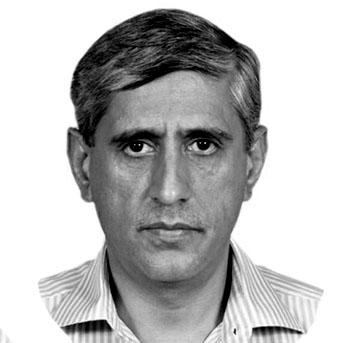Raashid Wali Janjua
LT Colonel Raja Sultan was a popular officer revered by his men despite his martinet like approach to command and an indefatigable spirit that demanded the very best from all those under his command. In late 1970 he was commanding his unit 22 Baloch at Quetta. His three children, two sons and a daughter were enjoying the amniotic warmth of family bliss that is engendered by the company of caring parents and a carefree cantonment life. On one late summer afternoon the call came for the unit’s move to East Pakistan. The news was received by a stoic forbearance by a wife used to the ambulatory inconveniences of military life and with cheerful alacrity by the plucky Colonel who like all true soldiers preferred battlefield action above all other avocations. He reached East Pakistan with his unit that was placed under 14 Division at Kulaura Maulvibazar. Pakistan’s 313 Infantry Brigade, part of Pakistan’s 14 Infantry Division, was located at Moulvibazar where 22 Baloch was to defend the area Sagarnal, Gazipur, Kulaura and Juri with additional companies consisting of reconnaissance forces and East Pakistan Civil Armed Forces troops. The battalion under Lt Colonel Raja Sultan had prepared the defences with full professional dedication and he went to every trench boosting the morale of the exhausted troops facing the combined brunt of the Indian 59th Mountain Brigade and the Mukti Bahini saboteurs. The brave officer was morally and professionally too upright to compromise on issues concerning the safety and professional reputation of his troops. He therefore always spoke his mind and never shied away from standing up for his men. In one of those acts he fell out of favour of higher commander who insisted on an operation that in the officer’s opinion was suicidal. He was therefore removed from the command and sent back to Eastern Command Headquarters.
His sterling professional reputation and charismatic leadership had preceded him in the command headquarters where soon he was assigned to the command of another battalion i.e. 32 Baloch. Pakistan Army held the North West Sector opposite Kishanganj-Siliguri corridor with 16 Infantry Division. It consisted of three sub-sectors. The Northern Sub-Sector was held by 23 Infantry Brigade to deny axis Dinajpur/Rangpur to Bogra. The Central Sub-Sector consisted of axes Hilli-Gaibanda–Bogra and Hilli-Jaipurhat-Khetlal-Bogra. It was also called the waistline and the shortest direct route to Bogra. It was the most important Sub-Sector that held the key to defence of Bogra. Indian 33 corps with three Infantry Divisions in offensive role and one in reserve along with an engineer brigade and three armour regiments was opposed by a depleted Pakistani division. Pakistani 205 Brigade commanded by Brigadier Tajamul Hussain Malik was defending the central subsector covering approach to Bogra.
Indian 340 Brigade was tasked to cut off the axis Rangpur-Bogra and to clear Pakistani troops at Hilli and Ghoraghat-Gobindaganj. Indian 2/5 GR infiltrated on night 07 December 71 and almost ambushed GOC and Commander 205 Brigade in the rear of Pakistani defended locations. A company of Indian 5/11 Gurkha Regiment infiltrated on the night 12/13 December 1971 between two forward companies of 32 Baloch deployed at Saulakandi and Malahar and established a road block in the rear. 32 Baloch then launched a fierce counter attack to clear the area of the Indian troops under its intrepid commanding officer Lt Colonel Raja Sultan. The doughty colonel throwing caution to the wind led the attack himself against the entrenched enemy battalion in a terrain favouring the defending Indian troops with advantages of clear observation and field of fire. According to Indian authors Lt General Yadava and V Ganapathy the fight between 32 Baloch and 5/11 GR and 2/5 GR was an epic in the classic infantry bayonet charge style.
The vastly outnumbered and heavily bombed Pakistani troops stood their ground and each trench had to be cleared through hand to hand fight by bayonets and Kukris. 97 Indian soldiers were killed as the hand to hand fight ensued with no quarters given. In one such encounter Lt Colonel Raja Sultan led the bayonet charge against the Gurkha troops. Displaying true gladiatorialelan and panache like the Muslim warriors of yore, he attacked an Indian Captain who fought back with his personal weapon. The two officers fought to death with Lt Col Raja Sultan embracing martyrdom on site while the Indian Captain Jatandir Nath Sood succumbed to his injuries in hospital. The gumption and uncommon heroics of the Pakistani commanding officer became a local lore with the Gurkha warriors who buried the colonel with full military honours. As the colonel was lowered in the grave with the rubicund splendour of his blood covered uniform a Gurkha soldier threw in his rank epaulettes in his grave motioning towards heavens that, “Let Him also know that the Sultan Bahadur was a Lt Colonel”. His family back home received the news of his martyrdom with equanimity remaining oblivious of his whereabouts for a long time since he was declared missing in action. Though in the confusion of the battle and the aftermath of surrender his debonair act of sacrifice was forgotten and he did not get any reward for his outstanding leadership and courage the remark of the Gurkha soldier and the Indian newspapers about his blood covered body was the true red badge of courage for the warrior.
— The writer, a Retired Brig, is a PhD scholar at NUST, Islamabad.










